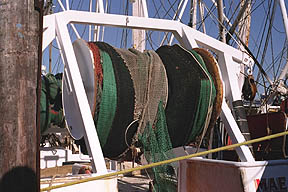

 |
| An otter trawl stowed on a net reel on a Point Pleasant dragger (N.Stolpe photo) |
 |
 |
| Otter trawling
- also known as dragging - is one of the most commonly used techniques
for fish harvesting. In otter trawling a large net, is dragged along the
bottom or up in the water column behind a towing vessel. The mouth of the
net is held open by two large "doors" which are attached to either side
of the net. The net is dragged behind the boat with a thick steel cable.
Once the back of the net, called the bag, is filled with fish, the net is hauled back aboard the vessel, the catch is spilled from the bag, and the net is redeployed. Depending on the fishery and the size of the vessel being used, otter trawls can have mouths ranging from thirty feet or so across up to hundreds of feet. These larger nets are towed by the large factory trawlers that fish in distant and often hostile waters like the Gulf of Alaska. While employed primarily to harvest bottom-dwelling fish like fluke, flounder, whiting and cod, trawlers also seek species that are more commonly found off the bottom like mackerel and bluefish. In catching these species a technique known as mid-water trawling is employed. Generally done at a faster speed than the two or three knots per hour used in dragging on the bottom, the net is fished at the depth at which schools of the species being sought are thought to be. Over the past several years there has been a growing concern about the impact that intensive trawling and/or dredging activities have on the habitat on the sea bottom. While little research addressing this issue has been done in the past, several groups have started programs to see what changes are caused by commercial fishing activities. (For a different perspective on fishing-related disturbances see FishNet #9) |
 |
| One of the trawl doors on the F/V Dyrsten in Cape May |